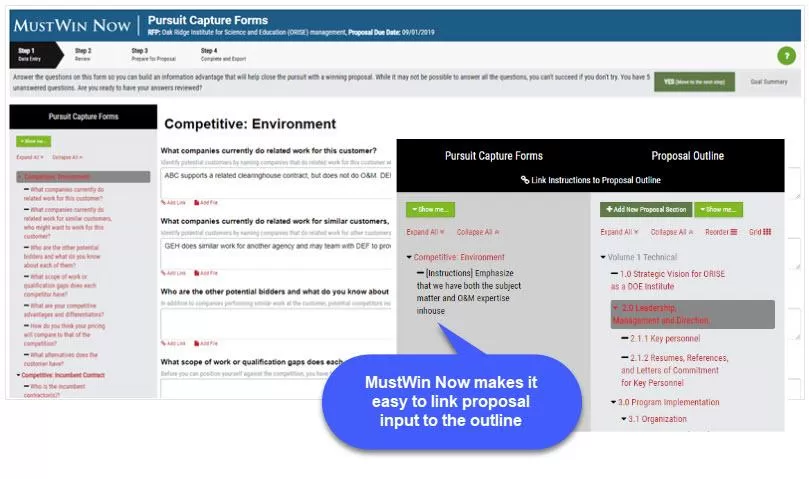When a pursuit starts before RFP release and you have time to gather intelligence, what do you do with what you’ve learned? How does it impact the proposal needed to close the sale and capture the win?
When a pursuit starts at RFP release, how do you quickly assess what you know and what you don’t know? And how does that impact the proposal needed to close the sale and capture the win?
If you are like most companies, you talk about it. A lot. And somehow very little of that talking makes it onto paper. You can't map a conversation to the relevant places in the proposal, let alone identify what words to put there all while simultaneously matching the RFP instructions and evaluation criteria. Some of the talk is relevant, but most of it isn’t. And a lot of time gets spent on it.
In the past we’ve recommended using proposal input forms as a way to:
- Aggregate what you know in a form that is relevant to what will go into the proposal
- Quickly assess what you know and what you don’t know so you can finalize how you will articulate your win strategies
- Drive your intelligence into the proposal so that your insights and information advantage can increase your chances of winning
In practice, proposal input forms become a gateway. When the RFP is released, they are one of the first action items to be completed. They provide vital information about what to say about the customer, opportunity, and competitive environment in the proposal. Proposal input forms enable proposal writers to combine what you propose to do with why it matters, and do it in a way that is optimized to win.
You can do this on paper, and in the past we have recommended that. After we created the online compliance matrix and content planning tools for MustWin Now, we created a Pursuit Capture Form tool. It provides a quick and easy way to implement Readiness Reviews and what amounts to an online capture plan. But it also enables us to make proposal input forms easier to implement. Instead of just a paper reference, you get something that’s not only an easier way to collect information, but it also provides better guidance to proposal writers.
 automatically sets up the content plan shell for you using the proposal outline, and it pre-loads all the RFP requirements from the compliance matrix. Then the very next step is to map the instructions from the proposal input forms to the proposal outline. This works the same way that MustWin Now links the RFP requirements to the outline when building the compliance matrix.
automatically sets up the content plan shell for you using the proposal outline, and it pre-loads all the RFP requirements from the compliance matrix. Then the very next step is to map the instructions from the proposal input forms to the proposal outline. This works the same way that MustWin Now links the RFP requirements to the outline when building the compliance matrix.

With simple drag and drop motions the instructions from the proposal input forms show up in the relevant proposal sections as instructions for proposal writers. This is the bridge. It directly connects your pre-proposal intelligence and strategy development with the specific places in the document where you should talk about them, while also providing guidance on how to talk about them.
Your insights about what matters and what it will take to win become guidance for your proposal writers. It makes it easy for the proposal writers to know what context to put their response to the RFP requirements in, and what points to make while doing it. And that context is the difference between being merely RFP compliant and winning.



Join the conversation
You can post now and register later. If you have an account, sign in now to post with your account.